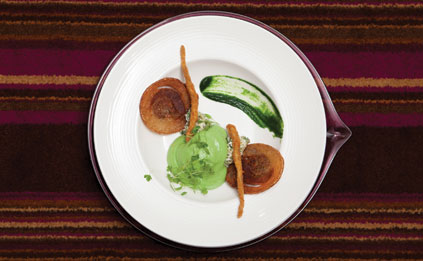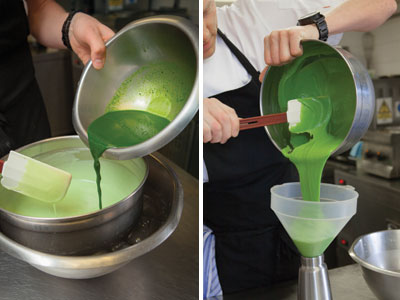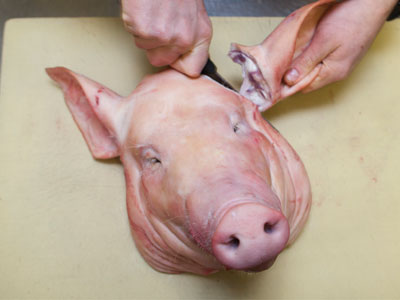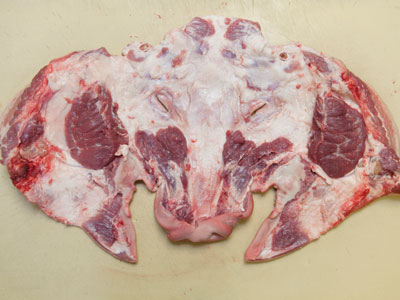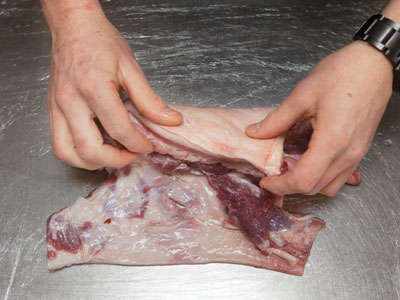Chef masterclass: Surf ‘n' turf by Will Holland
Born in the 1960s as steak and lobster, surf ‘n' turf has evolved to encompass any harmonious combination of meat and fish. At La Bécasse, chef-patron Will Holland serves a grown-up version using salt cod and Bath chaps. Michael Raffael reports
Surf ‘n' turf entered the culinary repertoire about 50 years ago, and one of the earliest references to it appeared in a Los Angeles Times article in 1961. At first it was a kind of shorthand for steak and lobster, but it has outgrown its origins and even its association with slightly dubious mid-West, mid-spend diners.
Of course, mixing seafood with meat didn't start in the USA. In the 18th century oysters were an integral part of a steak and kidney pudding, and larding lamb with anchovies is a classic French ploy. In oriental stir-frying, meat and shellfish are tossed together in the wok.
Planning Brandade: allow one day for salting. Once the mixture has been loaded into the siphon gun, 
it will keep for several days.
Bath chaps: allow one day for brining and 12 hours for cooking in the water bath plus chilling. The medallions are sliced and fried to order.
Costing At La Bécasse, the dish features as a starter 
on a multi-choice lunch menu for £30 for 
three courses. A pig's head (16 portions) costs £1.50; cod for the brandade costs about £7 per kilo for fillets, but that will yield about 30 portions as a starter.
The salt and aromats double the cost of the raw materials, but this is still a relatively cheap dish to make, though it is offset by being very labour-intensive.
PARSLEYED COD BRANDADE
The term 'brandade' derives from a ProvenÁ§al word describing something that is stirred. As a mashed salt cod dish, it can be traced back to the 16th century. In the traditional recipe it's eaten hot, but here it is served as a cold espuma.
There are many ways of salting cod. At one 
end of the scale is morue sèche, which is 
dried until it's hard - desalting can take 
days. At the other end are milder cures, which 
retain the original character of the fish. In new Scandinavian cuisine, for instance, the highest premium is paid for salted line-caught cod that 
is bled, like turbot should be, while it's still alive.
Holland buys fresh, line-caught cod from Brixham fish market in Devon. The fish size will vary, so he fillets the fish, cures the fillets for 24 hours, divides them into 285g batches and, where necessary, freezes them until needed.
Method
Filleting - for gutted fish Cut behind the pectoral fin at the side of the head to a point where the backbone joins the head. Turn the fish on to its other side and repeat the cut.
If the fish is large remove the 
head and gills by cutting through the bone 
with a serrated knife.
Following the line of the backbone, remove first one fillet then the other. Cut around 
the pelvic and anal fins - they are on the 
bottom of the fish. To trim each fillet, pare any gristly skin lying over the belly flap and pin-bone carefully. With a flexible-bladed knife, skin the fillets starting from the tail-end (4).
Salting and desalting
Work with the ratio of 10% sea salt to the total weight of cod fillet.
Ingredients 1kg trimmed cod fillet
100g Cornish sea salt
6 fresh bay leaves
6 sprigs thyme
16 black peppercorns
12 cloves
2 large garlic cloves, roughly chopped
Zest of 1 lemon
Method Rub the salt into the fillet - it should start 
to penetrate at once. Lay the fillet, cut 
side down, on a bed made of the aromatic ingredients, keeping back a few to place 
on top. Refrigerate for 24 hours.
Rinse the fillet to clean the surface and 
pat it dry with a towel or kitchen paper. 
It will be firm, waxy and quite salty.
Divide into 285g batches and freeze those 
that aren't needed at once.
BRANDADE BASE

Ingredients 285g salt cod, roughly chopped
500ml milk
250g dry Maris Piper mash (baked in jackets)
45g roughly chopped spring onions

Put the cod and milk in a small pan. 
Cover and bring to simmering point. Take 
off the heat and leave to finish poaching.
Add the potato and spring onion. Blend thoroughly in a liquidiser.
Pass the pale green cream through 
a fine sieve.
PARSLEYED BRANDADE ESPUMA 

Ingredients (Serves 16 as a starter)
For 2 x 500ml siphon guns
835g hot brandade base (above)
5 soaked gelatine leaves
215g parsley purée
While the brandade is hot, add the gelatine to dissolve it. Chill over ice until the mixture starts to thicken. Add the parsley purée and combine.
Fill the siphon gun with the brandade mix. Charge with two gas cartridges per siphon gun. Before using, shake the siphon thoroughly.
To make parsley purée for the brandade Blanch the leaves of flat-leaved parsley for 
five minutes, refresh in iced water, drain and liquidise until a smooth purée is formed.
To make the parsley fluid gel for the garnish Add 35g veggie gel to 500g of cold parsley 
purée and bring to the boil. Chill to form a 
jelly, blend until smooth, and store in a squeezy bottle until required.
BATH CHAPS

Ingredients 1 pig's head (serves 16 starter portions with
the brandade)
1.5 litres water
175g caster sugar
450g table salt
12 sprigs thyme
12 sprigs rosemary
24 dried bay leaves
20 juniper berries
20 allspice berries
20 cloves
2tbs black peppercorns
1tbs dried chilli flakes
Zest of 2 oranges
Zest 4 lemons
Put the water, sugar and salt in a pan, cover and bring to the boil. Take off the heat straight away and pour in the aromatic ingredients. Mix well and chill.
To bone and brine the head Cut off the ears and reserve for garnish (see 'Crispy pigs' ears' for method).
Turn the head so the underside of the jaw is uppermost. Use the tip of a boning knife to free one half of the head from the skull and then the other. The head should come away like a mask.
To trim the head, cut off the end of the snout and the gristle around the eardrums. Turn the head so the skin side is up and remove any bristles with a blowtorch. Cut the head in half lengthways. Each piece weighs about a kilo.
Put them in a container just large enough 
to hold them, and pour over the cold brine. 
Leave for 24 hours, rinse and pat dry.
Poaching the chaps To obtain a tightly rolled 'sausage' from each piece of pig's head, roll it lengthways.
Wrap 
it tightly in four layers of cling-film and tie both ends. Put each piece in a vacpack bag and seal under full pressure. Poach in a water bath for 
12 hours at 90°C.
- Chill thoroughly ahead of 
service, then unwrap and slice to order.
SALT COD BRANDADE ESPUMA, CRISPY BATH CHAPS, SAUCE GRIBICHE, PARSLEY PUREE

Ingredients (Serves 1)
1tsp sunflower oil
2 x 4-5mm thick Bath chap medallions
1tbs parsley fluid gel
2tbs sauce gribiche (see box)
2 strips of fried pigs' ear (see box)
About 80mm by volume brandade
Baby parsley cress
Heat the oil in a small frying pan. Add the medallions and fry over a low to medium heat 
for about four to five minutes each side. 
They should render some of their fat and 
become caramelised and crisp.
Squeeze a little parsley fluid gel on the 
plate and brush it in an arc. Put two piles of sauce gribiche on opposite sides of the plate and stand the chaps in them. Lay the pig's ears to the side. Siphon the brandade on to the centre of the plate and sprinkle the parsley cress on it.
Serve immediately.
Tips â- Put a lid on the pan when making brine 
to prevent evaporation.
â- When working with chilled espuma (siphons), stand them in an ice-filled ice bucket during service.
â- Cut large fish bones with a serrated knife.
â- Fill siphons with a funnel or piping bag, depending on the texture of the item.
SAUCE GRIBICHE
80g grated gherkins
150g grated hard-boiled egg white
50g diced shallots
60g grated hard-boiled egg yolk
40ml white wine vinegar
20g Dijon mustard

Combine all the ingredients and, before serving each portion, add a large pinch of chopped curly parsley to the sauce.
CRISPY PIGS' EARS
Vacpack the pig's ears and cook in a water bath for 12 hours at 90°C. Chill. Cut into strips lengthways. Dip in flour, beaten eggs and panko crumbs. Deep-fry for about 1 minute at 175°C. Drain on absorbent paper.
Other surf 'n' turf combinations from Will Holland
Monkfish and oxtail
Coq au vin and scallop
Chicken wing and langoustine
John Dory and smoked ham hock
Turbot and pig's cheek
WILL HOLLAND
La Bécasse in Ludlow may be owned by Will Holland's mentor Alan Murchison, but Will is very much his own man. And he has every right to be - the menu, the style of service and the cooking all reflect his taste.
Bristol born, Holland was eating two-star Michelin cuisine while still at school at Martin Blunos's Lettonie and never considered a career other than cooking. His first job was working for Gary Jones - then at Homewood Park near Bath. He next learnt his craft at Gravetye Manor, Sussex, under chef de cuisine Mark Raffan. He became Alan Murchison's sous chef at L'Ortolan in 2004 and was promoted to head chef the following year, before moving to open La Bécasse as chef-patron for Murchison at the age of 27.
La Becasse was soon recognised with a string of accolades including 6/10 in the Good Food Guide, and on a more personal level, Holland picked up an Acorn Award in 2009.
Last week, Holland announced that he would be leaving La Bécasse in September in order to pursue new opportunities.



